

MASSACHUSETTS BAY COLONY
When English emigrant William Lane, the patriarch of Aaron G. Lane's family in America, arrived in Boston in the mid-17th Century, the town had changed considerably from the time it was the Indian village of Shawmut. The wigwams, huts and hovels in which the English had lived 30 years earlier had been replaced, according to a contemporary description, by "buildings beautifull and large...orderly placed with comly streets."
Throughout Massachusetts Bay Colony stretches of wilderness had given way to gardens and farmlands. "There are supposed to be in the Mattachusets Government at this day," wrote Edward Johnson in about 1650, "neer a thousand acres of land planted for Orchards and Gardens, there being, as is supposed in this Colony, about fifteen thousand acres in tillage, and of cattel about twelve thousand neat, and about three thousand sheep."
The times were prosperous and the prospects were good for William to advance his trade as a cordwainer, or shoemaker, and comfortably support his large family. William had eight children, four of them by his second wife, Mary Brewer. It was Mary's second child, also named William, who was Aaron's great-great-grandfather.
WILLIAM LANE, THE "TYTHINGE MAN"
The son William, born in 1659, grew up in Boston and remained there until he was 27, earning his living as a tailor. He married Sarah Webster, whose father, Thomas, was the ancestor of the famous 19th Century statesman and orator, Daniel Webster.
William joined the North Church in 1681, and was named "Tythinge Man" in 1686, but before completing his term he moved up the coast to Hampton, New Hampshire, and settled on a ten-acre plot granted to him by the town officers. He had followed his father-in-law, who no doubt had a hand in obtaining the land for him.

Throughout William's lifetime and continuing until 1763, New England was engaged in nearly constant warfare with the French and their Indian allies, with short truces of a few years' duration in between. This forced the "tythinge man" to become a fighting man. William was described as a "devout and godly man," but like the other Puritans of early New England, he had no hesitation in taking up arms for defense. His exploits in the militia were many, and extended over a lengthy period, until age finally forced his retirement from the field of war.
William also had a good sized family by today's standards -- seven children in all -- though this was about average for the time and place. Aaron's direct ancestor was William's son, Samuel, who was born in 1698. Samuel became a farmer, and of his five children, he lost the first three in a terrible epidemic of diphtheria in the mid-1730s. His youngest child, Samuel, born in 1741 after the epidemic, was Aaron's grandfather.
AARON'S FATHER JONATHAN
SERVES IN THE REVOLUTIONARY WAR
In 1761 Aaron's father, Jonathan, the eldest of Samuel's nine children, was born in Hampton Falls, which is what the portion of Hampton south of Taylor's River came to be called after the town divided in the early 1700s. Jonathan was the fifth generation of Lanes to live in New England, and like most of his family before him, he was a farmer.
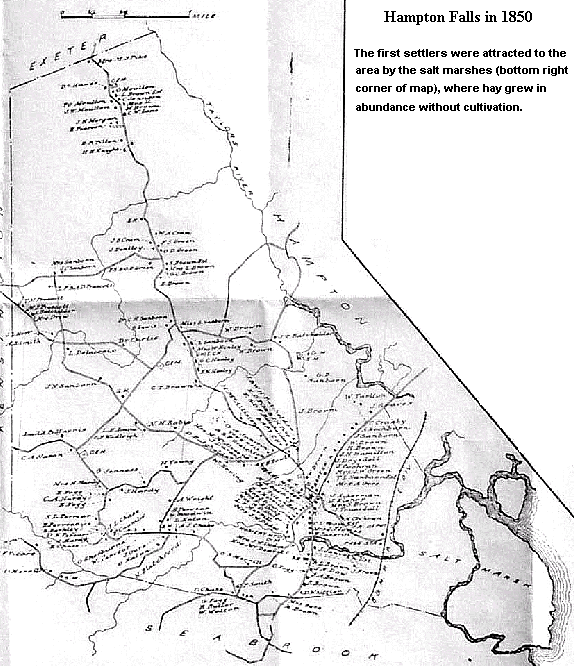
During the Revolutionary War, at age fifteen, he did a term of duty in the state militia as a private from December 5, 1776, to March 15, 1777. In 1779 he entered into the Continental Army and served in a company whose commander was Captain Goe. Throughout this latter period, his company was stationed in various forts along the Piscataqua River. He served as a cornet, or standard bearer, in the war, and thereafter was given the honorific "Cornet Lane" by his fellow townsmen.
In October of 1786, Jonathan married Lydia Leavitt, also a native of Hampton Falls, and the couple had five children. Ten years later almost to the day, on October 11, 1796, Lydia died at the age of 36 due to complications from childbirth.
On December 13, 1798, after two years as a widower caring for five children, Jonathan married 22-year-old Mary Towle. Mary, who went by the name of Molly during her years in Hampton Falls, had a pedigree extending back almost as far as Jonathanís, her original ancestor being Philip Towle, who settled in Hampton in 1657.
Jonathan, carrying on the Lane tradition of large families, had ten more children by Mary. The youngest of the children was Aaron Gove Lane, born December 18, 1818, in Hampton Falls.
AARON'S FATHER AND GRANDFATHER DIE
On September 6, 1819, about three months before Aaron's first birthday, his father died at age 58. What a tragic blow for this family with so many small children who would never get to know their father, and such a terrible hardship on them.
Whether Jonathan left an estate that would see them through for any length of time is unknown. No record of a will or probate can be found, but it is doubtful, with such a large brood to provide for, that there was any money to sustain the family outside of that which may have been realized from the sale of their homestead.
Mary did receive a small inheritance three years later from the estate of Jonathan's father, Samuel, who died early in 1822. The executors of the estate did an inventory of Samuel's property which showed that he had 55 acres of farmland, ten acres of land in town, and three and one-half acres of salt marsh, all of which, including buildings, appraised at $1,972. This real estate combined with all of his livestock, grain in storage, household goods and all other personal property, totaled up to a cash value of $2,612.20.
Grandfather Samuel treated Mary decently in his will, which reads, in part, "I give and bequeath to my daughter in law Molly Lane widow of my son Jonathan deceased three hundred dollars to be paid by my executor hereafter named at my decease." Three of Samuel's own children received only a total of $85 between them. The bulk of the estate went to Jonathan's younger brother, Samuel, who took care of his father in his later years.
THE FAMILY MOVES TO PIERMONT, NH
Shortly after Jonathan died, Mary, who was described as "an energetic Christian woman," bustled her family off to Piermont, New Hampshire, a picturesque community located along the Connecticut River on the western border of the state. The land in the area was going cheaply at that time, many parcels being sold merely for back taxes.
Mary took advantage of the opportunity and purchased farmland on the slope of a steep hill called Peaked Mountain, which was where Aaron grew up. The farm was on what later became known as Barton Road, just up the hill from Indian Pond Road. To the south, between Peaked Mountain and Piermont Mountain, is Clay Hollow, where kinsman Nathan Towle's house and farm were located. There were several Towles in Piermont, and presumably Mary moved there to be near them.
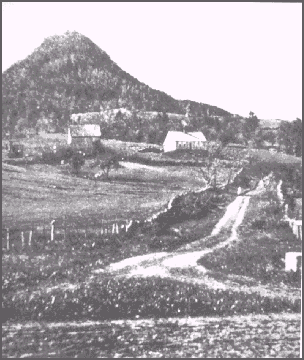
The first documentation of the Lane family living in the area appears on the Piermont Residents List, which was used for tax purposes, but Mary's name is given as the "widow Polly Lane." All Hampton Falls references list her as "Molly," whereas early Piermont references have her as "Polly." Beginning in 1831 she started using her given name, Mary.
The land Mary purchased was very rocky and not the best for farming in the area. However, the hill farms of Piermont, though the farmers had to work long hours to clear the rocks, did "provide good grain crops and suited family farm operations....Commercially, the hilly land suited Merino sheep farmers in the 1830-1860 period."
Mary had hard years ahead of her, but she had a large family to help her with the farm. Her children ranged in age from one to twenty, and she may have had some of Jonathan's children by his first wife living with her, three of them still being in their twenties. There certainly was enough work to keep the whole family busy.
LIFE ON A NEW HAMPSHIRE FARM IN THE EARLY 1800S
Life on a New Hampshire farm in those days was difficult; all work was done by hand with only the simplest tools. There were no mowers, no reapers or thrashers. Before Aaron left home, he would have been quite familiar with the use of the scythe, cradle and flail.
The inner strengths and knowledge Aaron gained during his years on the farm were to prove most useful in later life. He would have possessed the strong work ethic of the staunch Protestant settlers, who were also very frugal and resourceful. His mother's farm, if it were like the others of the time, was practically self-sufficient. The family grew their own crops, produced their own butter and cheese, made their own soap, spun their own yarn, and in countless other ways did for themselves.
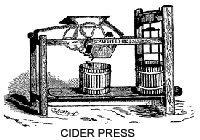
One other "essential" the farmers in Piermont produced for themselves was hard cider. In large quantities. The spirits helped these folks endure the long rigorous winters, during which time the consumption of the beverage often exceeded that which was considered socially acceptable in less severe times.
OLDER SIBLINGS COME OF AGE
During the mid-1820s, Mary's older children reached the age when they were ready to make a new life for themselves. Two of her daughters married, and her older sons struck out on their own shortly after reaching their majority, which is understandable, since it would have been difficult for the small farm to support such a large family of adults.
Mary's real estate holdings diminished during these years, possibly from selling some of it or perhaps giving portions of it to her sons. Her original purchase of 40 acres had been reduced to 30 by 1826, and the very next year, she only owned fifteen acres.
Aaron's half-brothers and sisters all married, except for one sister. His half-brother, Benjamin, married Irene Tucker in 1825, and the couple took up residence in Lake Village, New Hampshire. Benjamin moved to the farm in Piermont in 1856, probably to take care of his ailing stepmother, who was 80 years old by that time.
The 1856-57 Residents List shows Benjamin owning property called the "wid Lane place," so he either inherited the farm or bought out the other children's interests when Mary died in October 1857. He remained on the farm, evidently building it up in acreage, until his death in 1868, at which time the town records show that "Irena Lane" sold about 60 acres of land to a Parker and Hannah Felch.
Thus by the early 1830s, the size of Mary's household had considerably lessened. The only children still living at home were Aaron, who had now entered his teens, and a sister and two brothers. In 1831 Mary joined the Church of Saints in Christ, located in Clay Hollow.
LIFE IN PIERMONT IN THE MID-1800S
Because of the unceasing labor it took just to survive in this harsh, cold section of the country, there was very little social activity in the town. The one exception was the church. People literally flocked to the churches on Sundays, many of them traveling long distances, and for most of them this was their main contact with people outside of their own families. There were no local newspapers, so they gained their news of community events primarily at the church meetings.
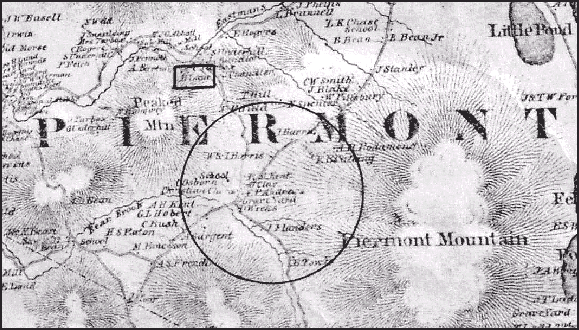
|
PORTION OF 1860 MAP OF PIERMONT. THE "B. LANE" (IN BOX) SHOWN ON THE NORTH SLOPE OF PEAKED MOUNTAIN REFERS TO BENJAMIN, MARY'S STEPSON, WHO ACQUIRED THE LAND IN 1857. CLAY HOLLOW, SHOWN IN CIRCLE, IS WHERE MARY'S KINSMEN LIVED. |
The population of Piermont was about 1,000 at this time, most of whom were farmers. There was no town center in the community, though there were some public or quasi-public buildings, such as schools, churches, and a meeting hall. It was not unusual for meetings simply to be held in houses given over to the purpose temporarily.
There was talk of building a town hall during the 1830s and 1840s, but the citizens could not reach an agreement on where the town should be, so the hall was not constructed until 1863. The 1840s saw few changes in the community of Piermont.
MEDICAL TREATMENT AND SANITATION
The town did boast at least one physician during those years, Dr. Zeeb Gilman, whom Aaron himself consulted. Dr. Gilman earned little as a physician, as did most others of his profession, and the circumstances in which his family lived were as rudimental as those of the rest of the community.
Dr. Gilman's son, also named Zeeb, later described the harsh conditions of rural living. He stated the family slept in a room with no windows, which was unheated and very cold in the winter. The beds had no springs, only slats or ropes on which was placed a mattress of cornhusks covered by a feather bed. The rugs on the floor mostly were made from rags, and lighting was supplied by whale oil lamps or candles.
Sanitation was bad. There was no plumbing, and water had to be pumped or carried. Flies were numerous, and often became so thick the family had to join hands and shoo them out with sprays of leaves. Everyone shared a common towel and drinking cup.
Handkerchiefs were seldom used, and Zeeb said he just wiped his nose on his sleeve and his dirty hands on the seat of his pants. At school the boys cleaned their slates by spitting on them and then wiping them with their sleeves. However, the girls were more fastidious; they, too, spit on their slates to clean them, but they used cloth rags to dry them.
Dr. Gilman, like most physicians of his time, also served as surgeon, pharmacist and dentist. His medicinal repertory would have included age-old herbal remedies. Purging the system was a popular method of treatment for many illnesses, so he would have prescribed the purgatives customarily used at the time, which included doses of calomel and jalapy, the former being particularly stringent.
Bleeding and the drawing of blood with a cupping glass were commonly practiced by many physicians, but to the good fortune of the townspeople of Piermont, Dr. Gilman did not believe in bleeding his patients. The doctor seldom used antiseptics, with boiling being his general means of disinfection. These methods sound terribly primitive from this perspective in time, but Dr. Gilman was a graduate of Dartmouth, and his medical knowledge was equal to that of most other practitioners of his day.
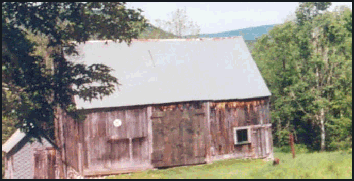
|
ORIGINAL 1820'S LANE FAMILY BARN AS IT APPEARS TODAY. THIS IS A 1992 PHOTO COURTESY OF MYRON M. MUELLER, RECORDING SECRETARY FOR THE PIERMONT HISTORICAL SOCIETY, AND OUR RESEARCH SOURCE IN PIERMONT. IT WAS SERENDIPITY THAT THE MUELLER FAMILY OWNS THE WIDOW LANE'S FARM. |
AARON BUILDS HIS OWN HOMESTEAD
Aaron had not been idle during these years. Judging from the Residents List, he was more active on the farm than any of the other Lane children. On the 1839 list, at age 21, he is shown as having one horse. The next year he had two horses and a cow, then two horses, one cow and eight sheep.
This pattern continued through the 1840s with Aaron increasing his stock every year, and in 1844 he is shown for the first time as having real estate worth $600. By the time he was in his late twenties, he owned what was listed as a "homestead."

During the mid-1840s, besides working on the farm, Aaron served in the state militia along with his brother, Moses. The two young men, who were thought to be twins by one Lane genealogist, were members of a cavalry company stationed in Piermont under the command of Captain Alexander Strong. In an official document dated October 13, 1845, Strong stated that Aaron and Moses Lane "...have been fully equipped and have faithfully and properly performed all the duties required by law the past year in said company."
When Aaron reached 28 years of age, after devoting eight years to building up his farm in Piermont, he suddenly decided to set out for himself and try new adventures. The United States had recently entered into war with Mexico following the annexation of Texas, and on March 31, 1847, A. G. Lane, as Aaron had been calling himself for several years, enlisted in Company H of the Ninth U. S. Infantry at Piermont, Grafton County, New Hampshire.
The Ninth, recruited entirely in New England, was one of three infantry regiments which, together with a battalion of marines, comprised the 2400 men under the command of newly-commissioned Brigadier General Franklin Pierce. Pierce had won a quick promotion when the Ninth was assigned to reinforce General Winfield Scott's army, which had advanced as far as the town of Puebla in Mexico.
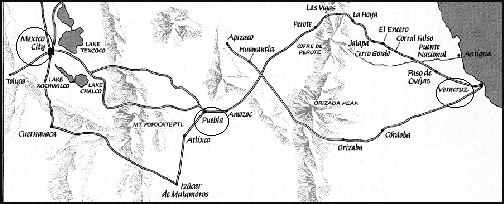
|
GENERAL SCOTT'S INVASION ROUTE FROM VERA CRUZ ACROSS CENTRAL MEXICO INTO MEXICO CITY. THE TOWN OF PUEBLA IS CIRCLED IN THE CENTER OF THE MAP. |
THE TROOPS SET SAIL FOR VERA CRUZ
The recruitment of Company H began in late March, and Lane was the second man to volunteer. The last recruits enlisted on May 7th, and on May 20th command of the company was assumed by Captain George Bowers. The next day, Private Lane and his regiment sailed for the Mexican port of Vera Cruz.
Three companies and most of the top-ranking officers were aboard the bark Kepler, while the remainder of the command, including Company H, sailed on the North Bend. The passage was long and wearisome, with the North Bend finally making port on June 21st, and the Kepler on the 27th.
Upon disembarking they found that no preparations had been made for the march to the interior, so several weeks were wasted in getting ready. At long last, on July 16th, Lane's regiment started on the road to Puebla, a town somewhat more than halfway between Vera Cruz and Mexico City.
THE MARCH TO PUEBLA
During the march, according to Lane, he was involved in several skirmishes with guerrilla bands, one incident being the fight for control of the Puente Nacional Bridge. The bridge was occupied and well defended, and the U. S. artillery could not be placed in a commanding position, so swords were ordered drawn, the command to attack given, and the men leaped over the barricades and routed the guerrillas.
The next day the troops reached the Rio del Plan and discovered that the bridge, described as being a work of art constructed by Spaniards, had been blown up. Lane's unit was in the advance that day, and the men, thinking the enemy was in force on the opposite side of the river, began descending the steep banks with the aid of trees and other supports, but by the time they scrambled up the other side, the Mexicans had already fled. This was a fortunate turn of events for the tired soldiers, who had to fight their way into Puebla, defending against guerrilla attacks on five separate occasions.
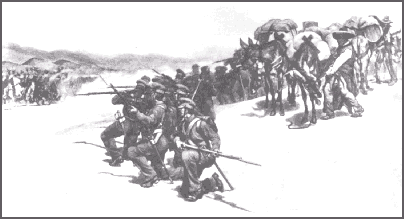
AARON CONTRACTS MALARIA
On August 7, 1847, the troops arrived triumphant in Puebla and joined with the rest of Scott's army. However, despite their successes in battle with relatively few casualties, the Army was seriously depleted due to the various diseases of the tropics, such as yellow fever and malaria.
It had been predicted by some Mexicans that these diseases might be Mexico's best line of defense against the Americans. This proved to be the case on the road to Puebla, where thousands suffered the debilitating effects of these illnesses.
Disease had killed more of Scott's troops on the march than had all the battles of the war up to that time, and it disabled thousands of others: one thousand men had remained in the hospital at Vera Cruz, about another 1200 were left at other towns along the road, and 1,017 were in the hospital at Puebla. In two short months 3200 soldiers, nearly one-fourth of the whole force, were incapacitated.
It was in the town of Puebla, on the 9th of August, 1847, that Aaron himself had to be hospitalized after contracting a tropical disease, which he later identified as malaria.
THE SIEGE OF PUEBLA
General Scott left the sick troops and about 1400 men behind with Colonel Thomas Childs, and continued on his way to conquer Mexico City "with naked blade in hand." Scott captured the capital, but Mexican General Santa Anna escaped, and soon after set out for Puebla with a segment of his army to attempt to recapture the city.
Before his arrival, on the night of September 13th, about 4,000 Mexican guerrillas surrounded the city and began to infiltrate it. Thus began a siege of nearly one month. Aaron was seriously ill by this time, and was bedridden, but many others had convalesced to the point where they could defend themselves, and their recovery was none too soon.
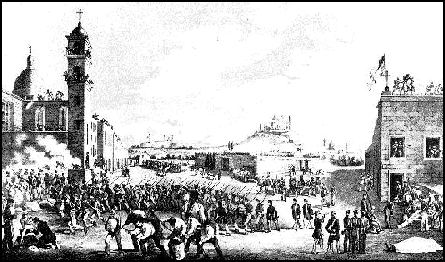
On September 22nd, General Santa Anna arrived with his forces and attempted to storm the city, but was driven back. Three days later Santa Anna informed Colonel Childs that he now had 8,000 men and that it was useless to resist. He demanded the colonel's surrender, but Childs refused, and on the 27th the assault resumed.
U. S. reinforcements under the command of General Joseph Lane (no known relation) were sent from Vera Cruz. Santa Anna turned to meet the challenge, but was defeated in the town of Huamantla.
Childs took advantage of the reduction in Mexican forces and sent his troops into hand-to-hand combat with the guerrillas, who by now had established footholds all through the city. On October 8th Santa Anna returned with reinforcements, and the Mexicans charged the city.
The U. S. soldiers, many sick and disabled, fought courageously and repulsed the attack; even with the onslaught of their total forces, the Mexicans were unable to overcome the defenders. The garrison's supplies were getting low, and the situation looked critical, but on the 12th of October, General Lane's column finally arrived and fought its way into Puebla, thus ending the siege.
By now U. S. forces had won several decisive battles in Mexico, and with General Scott occupying the capital, the Mexican government gave up further resistance. After some delay in negotiations, the Treaty of Guadalupe Hidalgo was signed on February 2, 1848, and the war was formally ended.
AARON QUALIFIES FOR DISABILITY PENSION
JOINS GOLD RUSH TO THE PACIFIC COAST
In April of 1848 Aaron transferred from Puebla to Company K at Pachuca, where he stayed until his discharge in August of that year. He then returned to Piermont, but he was still in poor health. He applied for a military pension, and in an affidavit dated October 20, 1849, stated, "...that I am and ever have been greatly reduced in strength and capacity to labor ever since my being left at the Hospital [in Puebla]."
Two doctors, Ira Evans and Zeeb Gilman, the physician in Piermont, both certified that Aaron was "rendered incapable of performing the duty of a soldier by reasons of his constitution being impaired from disease contracted by him while he was actually in the service...and in the line of his duty." The two doctors concluded:
...he is thereby not only incapacitated for military duty, but in the opinion of the undersigned is very considerably disabled from obtaining his subsistence from manual labor and we are of the opinion that he should receive, at least, half pension. |
Captain Bowers also testified to the facts of his enlistment and service, and finished by saying, "...I have no doubt his constitution was considerably impaired by said sickness on account of which he [was] left by me in the hospital at Puebla....His disease was contracted in the line of his duty." On the 13th of November, 1849, the Secretary of the Interior signed the document that qualified A. G. Lane as an invalid and eligible for pension at four dollars per month.
By this time Aaron had come to realize that his hometown was no longer suitable to his health or his ambitions. There was no future for him that he could see in struggling on his homestead in freezing temperatures. Word of the recent gold strikes in California had rippled across the nation, and in 1850, after wrapping up his affairs in Piermont, Aaron joined the rush to the Pacific Coast.

 PAGE
1|
2|
3|
4|
5|
6|
7|
8|
9|
10|
11|
12
PAGE
1|
2|
3|
4|
5|
6|
7|
8|
9|
10|
11|
12

